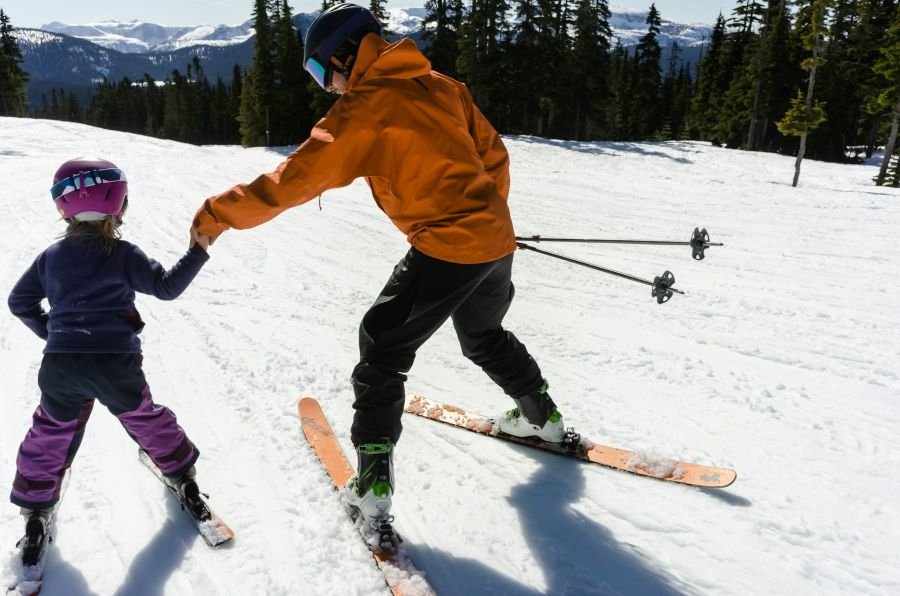7 Tips for Ski Trips with Kids
/Credit: unsplash.
Family ski trips. The dream is perfect powder days, rosy-cheeked smiles, and hot chocolate by the fire. The reality? Often far different.
You've spent thousands on lift tickets, accommodation, and rentals. Then suddenly… you're wrestling tiny boots onto crying toddlers, chasing lost gloves, and hearing "I'm cold" after just 15 minutes on the mountain.
And those picture-perfect families gliding effortlessly past you? They know something you don't.
After years of family ski adventures (and plenty of disasters), I've distilled the wisdom into 7 essential tips that actually work. These strategies will help you spend less, stress less, and create those magical snow memories you've been dreaming about.
1. Rent outerwear to save money
Kitting out the whole family for a ski trip can be incredibly expensive, especially when children outgrow clothes so quickly. Renting ski outerwear is a brilliant solution that can save you significant money whilst ensuring everyone stays warm and dry on the slopes.
Many ski resorts and nearby rental shops offer affordable outerwear packages specifically for children.
You'll find that as long as you choose a high-quality rental store, gear is typically decent and well-maintained. Generally, you’ll find that independent ski hire places like Snopro offer a better selection of outwear and equipment compared to the bigger name discount brands. This means you don't have to compromise on keeping your little ones protected from the elements whilst saving money.
For families who ski only once a year, renting makes much more financial sense than purchasing expensive gear that might not fit next season. It's also a brilliant way to try different styles and brands before committing to buying your own.
Remember to book your rental gear early, especially during peak holiday periods. Many rental companies offer online booking with discounts for advance reservations.
2. Get started with ski school
Enrolling your children in ski school is one of the best decisions you can make for a successful family ski holiday. Look for ski schools with small class sizes, as this ensures your child receives the personal attention needed to advance faster.
Most ski resorts offer lessons specifically designed for different age groups, with instructors trained to make learning fun and engaging for little ones. Book these lessons well in advance, especially if you're travelling during peak holiday periods.
Consider scheduling morning lessons when your children are fresh and energetic. This leaves afternoons free for practising together as a family or simply playing in the snow.
Many ski schools offer package deals that include equipment rental, which can save you money and the hassle of fitting gear separately. Some resorts even have 'kids rent free' programmes worth looking into.
Don't plan for all-day lessons right away, particularly for very young children. Start with shorter sessions and gradually increase the duration as they build confidence and stamina on the slopes.
3. Use tip ties help control skis
Ski tip connectors, often called 'edgie wedgies' or simply 'tip ties', can be a brilliant aid for young children learning to ski. These simple devices clip onto the front of your child's skis, connecting the tips together to help them maintain a wedge position.
For little ones who haven't yet developed the leg strength needed to hold a snowplow position, tip ties provide much-needed support. The connection makes it significantly easier for your child to control their speed and direction whilst learning.
You can find these handy tools in most ski shops near family-friendly resorts. They're typically inexpensive and can make a massive difference to your child's confidence on the slopes.
Some parents even create makeshift versions using tie-down straps (like those used for roof racks). Simply loop the strap around both ski tips and secure it tightly.
Remember that tip ties are best used as a temporary training aid. As your child builds confidence and strength, they'll gradually need to learn to control their skis independently.
4. Pack plenty of snacks for energy and mood boosts
Keeping your little ones fuelled throughout a ski day is absolutely essential. When children get hungry, their energy levels drop dramatically and tantrums can quickly follow, potentially ruining everyone's day on the slopes.
Think portable and hearty options that can be easily eaten on chairlifts or during quick breaks. Trail mix with nuts, seeds, dried fruit and chocolate bits makes for a perfect grab-and-go energy boost that children love.
Protein-packed snacks like cereal bars, peanut butter crackers, and cheese sticks help maintain energy levels longer. Remember that skiing burns loads of calories, so don't be surprised if your kids are hungrier than usual.
Pre-make some breakfast burritos the night before for a substantial mid-morning snack. These can be customised to your children's tastes whilst providing the protein they need for sustained energy.
Don't forget the treats! A bit of chocolate or their favourite sweet can work wonders for morale during a challenging moment. Stash these special treats in your pocket for when spirits need lifting.
Always pack more snacks than you think you'll need. Cold weather increases appetites, and having extra means you won't need to pay premium prices at mountain cafés.
5. Don't forget goggles to protect little eyes from snow
Ski goggles are an essential piece of kit for children hitting the slopes. They protect young eyes from harmful UV rays, which can be particularly intense when reflected off snow surfaces.
The winter sun can be deceptively strong, even on cloudy days. Quality goggles with at least 95% UV protection are vital to safeguard your child's developing vision while they enjoy their skiing adventures.
Goggles also provide crucial protection from wind, snow, and ice particles that can irritate or potentially damage eyes. When your little ones are zooming down the slopes, the last thing you want is for them to squint against blowing snow or brightness.
Choose goggles specifically designed for winter sports that fit properly around your child's face. A good fit ensures no gaps where cold air or snow might enter.
For warmer, sunnier days, wrap-around sunglasses with UV protection can be an alternative. However, goggles typically offer more comprehensive protection, especially in colder or snowier conditions.
Remember that children are more susceptible to eye damage than adults, as their eyes are still developing. Protecting their vision should be a top priority during any ski trip.
6. Choose a child friendly resort
When planning your family ski holiday, selecting a resort with the right amenities for children can make all the difference. Look for resorts that offer dedicated children's areas with magic carpets and gentle slopes designed specifically for beginners.
Many family-friendly resorts provide specialised childcare programmes and ski schools with small class sizes. This ensures your little ones receive personalised attention, helping them progress more quickly and confidently on the slopes.
Consider accommodation options located close to the slopes to minimise the trek with tired children and heavy equipment. Ski-in/ski-out lodging is ideal for families, saving you the hassle of lengthy walks or shuttle rides with children in tow.
Check if the resort offers additional activities beyond skiing. Indoor pools, tubing parks, or ice skating rinks provide fantastic alternatives when your children need a break from skiing or if weather conditions aren't favourable.
Some resorts offer useful perks like 'Kids Rent Free' packages or discounted family tickets. Keystone Resort, for example, is known for its family-friendly atmosphere and special offers for children, making it easier on your wallet.
7. Take regular breaks to keep spirits high
Skiing with kids requires a thoughtful approach to pacing. Regular breaks throughout the day can make all the difference between a memorable family adventure and a meltdown on the mountainside.
Children tire more quickly than adults, especially in the cold and at high altitudes. Plan 15-20 minute breaks every hour or so, allowing everyone to rest their legs and warm up properly.
The promise of hot chocolate can be a powerful motivator when energy levels start to dip. Use these treats as rewards for completing runs or mastering new skills on the slopes.
Pack small, easily accessible snacks in your jacket pockets. A few gummy bears or small chocolates can boost spirits instantly when fatigue sets in.
Breaks also provide perfect opportunities to hydrate and refuel with proper meals. Skiing burns significant energy, and hungry children rarely have fun.
Choose comfortable, warm spots for your breaks. Many ski resorts offer family-friendly rest areas where you can relax without feeling rushed.
Remember that the goal is enjoyable family time, not maximising slope hours. Quality skiing experiences with happy children will create far better memories than pushing through exhaustion.
Packing Essentials for Kids
Preparing for a ski trip with children requires careful planning to ensure they stay warm, comfortable, and safe on the slopes. The right gear makes all the difference between a day of fun and a day of complaints.
Must-Have Clothing
When packing clothing for kids' ski adventures, the key is layering. Start with thermal base layers that wick moisture away from the skin. These should be made of synthetic materials or merino wool—never cotton, which stays damp when wet.
For the middle layer, pack fleece jumpers or insulated tops that provide warmth without bulk. These can be removed easily if temperatures rise during the day.
Waterproof, breathable ski jackets and trousers are non-negotiable. Look for items with snow gaiters to prevent snow from getting inside boots.
Daily Clothing Checklist:
2-3 sets of thermal base layers
2 fleece jumpers
Waterproof ski jacket and trousers
3-4 pairs of ski socks (wool blends are best)
Neck gaiter or balaclava
2 pairs of waterproof gloves or mittens (mittens are warmer for little hands)
Warm hat that fits under helmet
Safety Gear Checklist
Proper safety equipment is absolutely essential for children on the slopes. A well-fitting helmet is the most important item—never compromise on this. It should sit snugly without rocking back and forth or side to side.
Quality ski goggles protect young eyes from harsh glare, wind, and snow. Look for ones with UV protection and ensure they create a proper seal with the helmet.
Safety Equipment List:
Helmet: Must meet current safety standards and fit properly
Goggles: Should be compatible with helmet and offer UV protection
Sun cream: Minimum SPF 50, applied regularly
Lip balm: With sun protection
Refillable water bottle: To stay hydrated throughout the day
Small backpack: For carrying snacks, water, and extra layers
Consider a high-visibility vest or bright clothing to help you spot your child easily on busy slopes. Some parents also find walkie-talkies helpful for older children who might ski slightly ahead.
Disclosure: This is a collaborative post.























